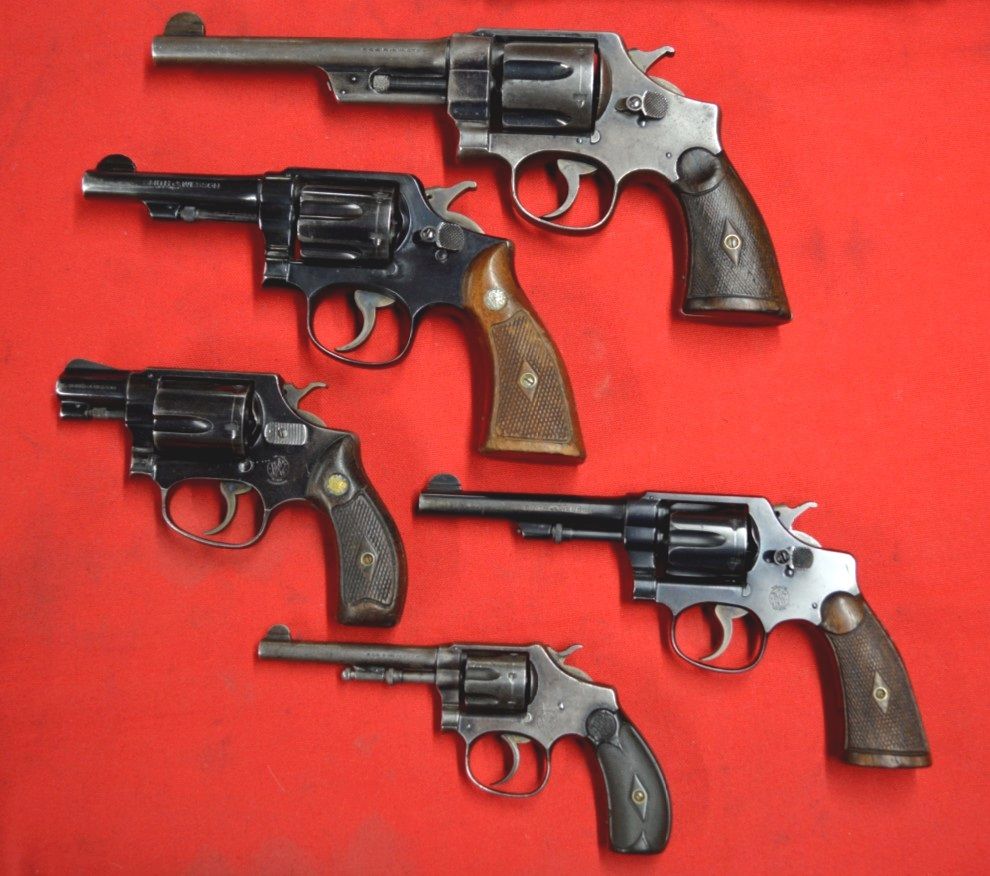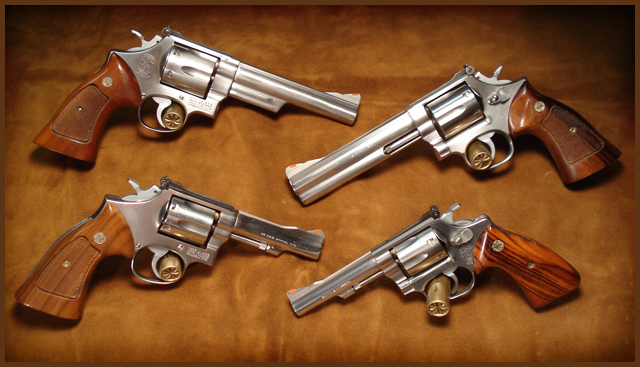You are using an out of date browser. It may not display this or other websites correctly.
You should upgrade or use an alternative browser.
You should upgrade or use an alternative browser.
Frames? Can someone please explain?
- Thread starter Kimio
- Start date
"...size you choose would mostly depend on your intended use..." Nope. It's about how well the revolver fits your hand. Mostly about the reach to the trigger.
'J' frame grips are tiny, wee, things that can be fixed by changing the actual grip. A 'K' will fit your hand or it won't. They can sometimes be made to fit better, if it's too small, by changing grips. Too big cannot.
And then it gets weird. The grip frame on a 2 or 3 inch M19/66 is the same as a 'J' frame and putting a Pachmayr grip on makes it fit normal sized hands that the regular 'K' frame does not.
"...never heard of an "N" frame..." Model 28, 29, 25, et al.
'J' frame grips are tiny, wee, things that can be fixed by changing the actual grip. A 'K' will fit your hand or it won't. They can sometimes be made to fit better, if it's too small, by changing grips. Too big cannot.
And then it gets weird. The grip frame on a 2 or 3 inch M19/66 is the same as a 'J' frame and putting a Pachmayr grip on makes it fit normal sized hands that the regular 'K' frame does not.
"...never heard of an "N" frame..." Model 28, 29, 25, et al.
Technosavant
New member
For size comparisons, the .357mag is available in four of the five current-offering frame sizes from S&W. In these various sizes, the window in the frame gets larger and larger, allowing for more capacity in the cylinder.
J frame: 5 shot
K frame: 6 shot
L frame: 7 shot (they make 6 rounders in this size, but the L is slightly larger so they can fit another)
N frame: 8 shot
I'd like to see if S&W could fit 9 or 10 in the X frame, but that's just because I'm weird.
J frame: 5 shot
K frame: 6 shot
L frame: 7 shot (they make 6 rounders in this size, but the L is slightly larger so they can fit another)
N frame: 8 shot
I'd like to see if S&W could fit 9 or 10 in the X frame, but that's just because I'm weird.
HighValleyRanch
New member
"...size you choose would mostly depend on your intended use..." Nope. It's about how well the revolver fits your hand.
Most people would not choose to stuff an N frame in their pocket, nor would they choose to shoot competition with a j frame.
Wrong again. A model 19/66 is K frame square or round butt. J frame is smaller. You cannot put j frame grips on a k frame....(and them fit correctly)And then it gets weird. The grip frame on a 2 or 3 inch M19/66 is the same as a 'J' frame
Driftwood Johnson
New member
Howdy
It's really a lot simpler than all that.
At least in S&W land. In the early days of Tip Ups and Top Breaks, frame sizes were numbered. 1, 1 1/2, 2, & 3. We can go into that at another time.
With the coming of the models with side swinging cylinders (Hand Ejectors) S&W gave the frames letters. M, I, K, and N. Let's talk about M in a minute. The other three were the sizes that could house a cylinder that could accept six cartridges. I for six 32 caliber cartridges, K for six 38 caliber cartridges, and N for six 44 caliber cartridges. It's that simple.
That is not to say that five shot versions of some of these did not exist for larger cartridges, they did. But in the beginning I, K, and N size frames were developed to house cylinders that had six chambers for each of those three calibers.
Later, the I frame was stretched to accept longer cylinders that could accept five 38 Special cartridges, resulting in the J frame.
The tiny Ladysmith was the only revolver made with the M frame. A seven shot revolver chambered for the 22 Long. Only made from 1902 until 1921.
Pictures are worth 1000 words because words are meaningless without comparison photos department:
Top to bottom:
N Frame 44 Special Triple Lock
K Frame 38 Military and Police
J Frame Model 36 (Chiefs Special)
I Frame 32 Regulation Police
M Frame Ladysmith

Camera Shy:
L Frame Model 686. This size is between the K and N in size. It was developed to increase the diameter of the cylinder slightly from the K frame. This was done so 357 Magnum revolvers could be made without a relief cut on the underside of the forcing cone. The relief cut on the forcing cone was often a problem because the forcing cone could split with some 357 Magnum loads.
Also Camera Shy:
X Frame. A ridiculously over sized frame developed for ridiculously overpowered revolver cartridges such as 454 Casull, 460 S&W Magnum, 500 S&W Magnum.
Z Frame. An even more ridiculously over sized frame for the Governor; 45 ACP/45 Colt/410 Shotgun cartridges.
X Frames and Z Frames are not allowed in my house.
It's really a lot simpler than all that.
At least in S&W land. In the early days of Tip Ups and Top Breaks, frame sizes were numbered. 1, 1 1/2, 2, & 3. We can go into that at another time.
With the coming of the models with side swinging cylinders (Hand Ejectors) S&W gave the frames letters. M, I, K, and N. Let's talk about M in a minute. The other three were the sizes that could house a cylinder that could accept six cartridges. I for six 32 caliber cartridges, K for six 38 caliber cartridges, and N for six 44 caliber cartridges. It's that simple.
That is not to say that five shot versions of some of these did not exist for larger cartridges, they did. But in the beginning I, K, and N size frames were developed to house cylinders that had six chambers for each of those three calibers.
Later, the I frame was stretched to accept longer cylinders that could accept five 38 Special cartridges, resulting in the J frame.
The tiny Ladysmith was the only revolver made with the M frame. A seven shot revolver chambered for the 22 Long. Only made from 1902 until 1921.
Pictures are worth 1000 words because words are meaningless without comparison photos department:
Top to bottom:
N Frame 44 Special Triple Lock
K Frame 38 Military and Police
J Frame Model 36 (Chiefs Special)
I Frame 32 Regulation Police
M Frame Ladysmith

Camera Shy:
L Frame Model 686. This size is between the K and N in size. It was developed to increase the diameter of the cylinder slightly from the K frame. This was done so 357 Magnum revolvers could be made without a relief cut on the underside of the forcing cone. The relief cut on the forcing cone was often a problem because the forcing cone could split with some 357 Magnum loads.
Also Camera Shy:
X Frame. A ridiculously over sized frame developed for ridiculously overpowered revolver cartridges such as 454 Casull, 460 S&W Magnum, 500 S&W Magnum.
Z Frame. An even more ridiculously over sized frame for the Governor; 45 ACP/45 Colt/410 Shotgun cartridges.
X Frames and Z Frames are not allowed in my house.
HighValleyRanch
New member
The Ruger's don't use the J, K, L, or N designation.
But maybe you are comparing the Ruger's size to the Smith versions?
The Ruger Security six is very slightly larger than the K, but not as big as the L version.
But maybe you are comparing the Ruger's size to the Smith versions?
The Ruger Security six is very slightly larger than the K, but not as big as the L version.
aarondhgraham
New member
Here is a good comaprison picture,,,
All four of the common S&W frame sizes:

Top to bottom:
Aarond
.
All four of the common S&W frame sizes:

Top to bottom:
- 629 N-frame in .44 Magnum
- 686 L-frame in .357 Magnum
- 67 K-frame in .38 Special
- 63 J-frame in .22 LR
Aarond
.
Mike Irwin
Staff
"I THINK it's an "I" frame, but I'm not sure at this point if it's an "I" an "Improved I" or what, but it gives you an idea of the size."
The red box means that it could be either an I frame or an Improved I frame.
Easy way to tell which, though...
If it has a strain screw on the bottom front grip strap, it's an I frame.
If there's no strain screw, its an Improved I frame.
I can tell you that it is a later production gun because it appears to have the modern single piece ejector rod, as opposed to the early mushroom head or the later fat sleeve.
The red box means that it could be either an I frame or an Improved I frame.
Easy way to tell which, though...
If it has a strain screw on the bottom front grip strap, it's an I frame.
If there's no strain screw, its an Improved I frame.
I can tell you that it is a later production gun because it appears to have the modern single piece ejector rod, as opposed to the early mushroom head or the later fat sleeve.
Does the type of from offer a mechanical or ergonomic advantage over one design over the other?
I don't know your stature or how you're screwed together, but to answer your question... from another perspective. I'm not a big feller at 5'10' / 215, but I once took the notion to see if it might be possible to get even somewhat accustomed to CCing an N Frame 4" M28 in .357 Magnum. I believe that decision might rank pretty far up on the list of my all time bad ideas. That was a lot of weight tugging on my breeches, totally threw off my alignment, had a tendency to walk around in right hand circles unless I tied a counterweight brick to my left side. It took 2 weeks for me to decide: This ain't fun. Nobody's paying me for this type of suffering. And, I've got much lighter pea shooters to walk around with.
Don't get me wrong- N-Frames are heaven on earth to shoot, but unless you can hire a Sherpa kid to carry it for you, smaller lighter revolvers sure gain some appeal.
